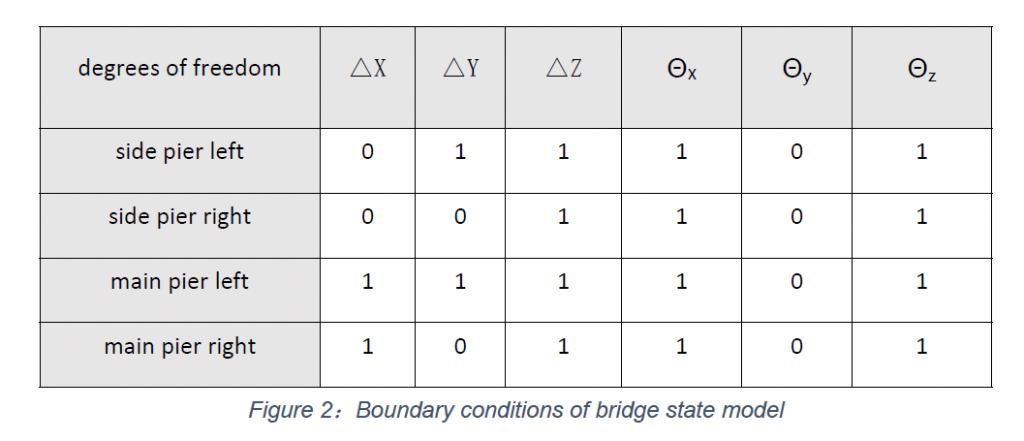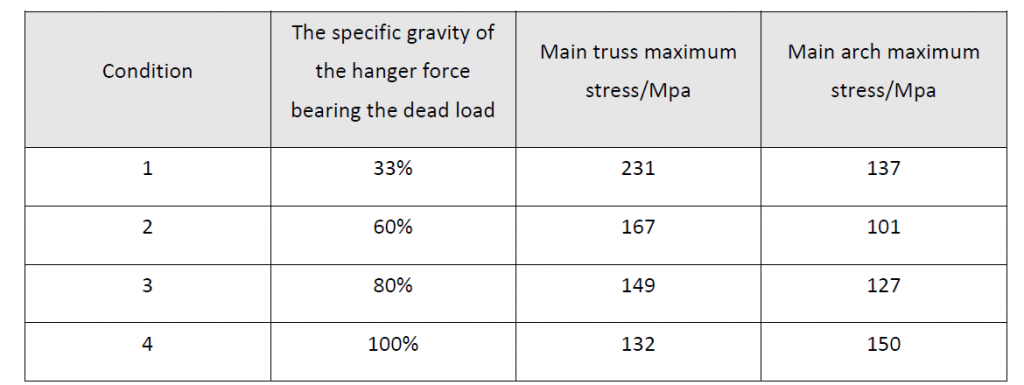1.Background:
The double-layer stacked arch is a new type of structure developed in recent years. Compared with
the conventional tie-rod arch, the shape is more graceful and dynamic. The curved arch bridge in this
design belongs to the overhead arch bridge according to the position of the carriageway. If viewed
from the cross-section of the main arch ring, it is composed of several parts such as arch ribs, arch
waves, arch plates and transverse connections. Since the arch wave between arch ribs is also curved
and orthogonal to the curve of the main arch circle, it is necessary to analyze the designed structure
first.
2. Structural static analysis:
Rigid connections are set between the side span arch ribs and the main girder, and between the main
girder and the bridge deck unit.
The boundary conditions of the completed bridge are shown in the table. x represents the
longitudinal bridge direction, y represents the horizontal bridge direction, and z represents the
vertical direction. 0 means free, 1 means fixed.
The proportion distribution of loads borne by arches and beams directly determines whether the
stress on the arch bridge structure is reasonable. The dead load is transmitted to the main arch
through the suspender, and the force of the suspender is the most intuitive expression of the
proportion of the main arch bearing the dead load. Comparing and analyzing the cases where the
suspender force of the completed bridge bears 33%, 60%, 80% and 100% of the dead load weight, the
force situation of the main components of the bridge is obtained, and the results are shown in the
table.
When the boom force is 33% of the dead load, the stress of the main girder is too large, the truss
section needs to be increased, the amount of steel is increased, and the dead load is also increased.
The proportion of the structure bearing its own dead load will also increase, and the economy is poor.
It shows that the dead load distribution ratio of the arch beam is unreasonable. When the boom force
is 60%, 80%, 100%, the force of the main girder and the main arch is small, which meets the
requirements of the code and has a certain margin. From the point of view of stress, the three
distribution ratios are all feasible, but from the point of view of the overall stability of the arch bridge
(especially the upper arch) and buckling stability, the main arch is a compression member, and the
stress should not be too large, and the main beam is a bending member. , can give full play to the
advantage of the high stiffness of the main beam, and the stress of the main arch should be reduced
as much as possible. Comparing the stress level of the arch under the second, third and fourth
working conditions, the stress level of the arch under the second working condition is the lowest and
the stability is the best. Therefore, it is finally determined that the boom force bears about 60% of the
dead load weight.
3. Slope-span ratio:
The rise-span ratio is one of the important parameters of an arch bridge, which has a great influence
on the overall force and deformation of the structure. A smaller rise-span ratio makes the axial shape
of the arch closer to that of a flat arch, and the axial force in the arch ribs and tie beams increases,
while the vertical stiffness of the structure decreases.
In the design of this system, the arch axes of the main and auxiliary arch ribs are all quadratic
parabolas. The main arch rib has a relatively high section stiffness and is the main arch structure. The
main and auxiliary arch ribs are connected by tie rods to form a stable system of space.
Select 5 different engineering rise-span ratios such as 1/5, 1/4.5, 1/4, 1/3.5, 1/3 for calculation and
analysis, (during the calculation, keep the span constant, and obtain different Sagittal Ratio).
When the rise-span ratio of the main arch rib is small, the stability coefficient of the structure
increases with the increase of the rise-span ratio. When the rise-span ratio increases to a certain
value, the stability coefficient reaches the maximum and the structure is most stable. The rise-span
ratio continued to increase, and the stability coefficient showed a downward trend. This is because
the decrease in rise-span ratio increases the axial pressure of the arch rib, and the axial pressure is
inversely proportional to the geometric stiffness of the member, resulting in a decrease in the overall
tangential stiffness of the arch rib and a decrease in the stability of the structure. When the rise-span
ratio is greater than the ideal stable rise-span ratio value, the component force of the stay cables in
the main arch rib surface increases continuously with the increase of the rise-span ratio, so that the
axial pressure of the arch rib does not decrease but increases. leading to a downward trend in the
stability of the structure. Calculations show that under the condition that other conditions remain
unchanged, there is an ideal rise-span ratio that makes the concrete-filled steel tube double-layer
stacked arch bridge the most stable, so the rise-span ratio of the main arch rib should be as close to
this value as possible during design.
In general, the increase of rise-span ratio will significantly reduce the axial force of arch rib and tie
beam, the deflection of tie beam, the force of boom, and the bending moment, but it is relatively
insensitive. As the rise-span ratio increases, its influence on the structural force gradually weakens, so
the higher the rise-span ratio, the better. At the same time, an excessively large rise-span ratio will
increase the amount of materials and affect the aesthetics of the structure. The choice of rise-span
ratio also needs to take into account the requirements of structural force and economical beauty. On
the whole, the rise-span ratio of double-stacked arch bridges is more appropriate to be around 0.28,
but not less than 0.25.
4.The thickness of the arch ring:
The arch at the top of the arc of the dome can distribute the pressure to both sides, and the
load-bearing capacity is better. Enhance the sense of depth of the space, but also enrich the visual
experience. And beautiful and interesting, adding a romantic and elegant atmosphere to the space.
The arch ring can be made into two forms of equal thickness and unequal thickness. In real life, equal
thickness is generally used. This form of equal thickness will also be used in this design, and it is a
long-span arch bridge. The value is based on the bridge span, loss The height, building materials and
load size shall be determined through trial calculation.
For reinforced concrete slab arch thickness:
Arch thickness: h =(1/200~1/250)L

5. Rigidity of the main arch rib:
In the stability calculation of CFST double-layer stacked arch bridge, the most critical part is the
selection of CFST arch rib stiffness. The calculation methods of arch rib stiffness mainly include:
conversion section method, superimposed element method and unified theory method. The
converted section method is based on the principle of equivalent stiffness. The area of CFST is
converted into the area of steel tubes according to the equivalent principle of compressive stiffness,
and then the stiffness of CFST components is calculated by the basic method. The superimposed
element method is to divide the concrete section of the steel pipe into two parts, concrete and steel
pipe, and consider the coordination of the longitudinal strain of the steel pipe and concrete to obtain
the stiffness of the member. The basic idea of the unified theory method is to convert the steel pipe
concrete into a material, select the correct constitutive relations of steel and core concrete under
complex stress conditions, and use the equilibrium conditions and deformation coordination
conditions to synthesize the two constitutive relations The combination relationship of components
includes the tightening effect in the combination relationship, and then establishes the internal and
external force imbalance conditions and deformation coordination conditions, and finds the
relationship between internal force, (or stress) and strain.
As we all know, in the construction process of composite arch bridge, the main arch, main girder, sling
and auxiliary arch rib support, cast-in-place bridge deck, and pavement of construction bridge deck
must have the problem of stress superposition. Therefore, it is unreasonable and unrealistic to
calculate the various components of the cross-section formed by stages as the overall cross-section
formed at one time. Therefore, the stress calculation of the double-layer stacked arch bridge should
consider the stage-by-stage formation process of the section, and calculate according to the stress
superposition method.
6. Summary:
Double-layer stacked arch, double-layer steel arch bridge is narrower and taller than ordinary
single-layer steel arch bridges due to the configuration of double-layer decks, so its structure and
mechanical behavior are different. The bridge is complicated, so it depends on the actual situation
and is determined after trial calculation.
Here You can Find the Parametric Model: Dynamo File



